


|
Castle Rising Castle. |

 Taken from Information Leaflet.
Taken from Information Leaflet.Castle Rising Castle is one of the most famous 12th century castles in England. The stone keep, with particularly fine arcading and embellishments on the fore building, was built around 1140, by William D'Albini to show his increased importance on his marriage to Alice of Louvian, widow of Henry I.
Although the main section of the roof no longer exists, the walls are fully intact, and some of the rooms are in near perfect condition. This together with the massive earthworks, reaching in some places to 120 feet high, ensures that Rising is a castle of national importance.
In it's time Rising has served as a hunting lodge, royal residence, and for a brief time in the 18th century even housed a mental patient. The most famous period in it's history was when it was home to Queen Isabella the mother of Edward III, following her part in the murder of her Husband, Edward II. Records show that she was visited at Castle Rising by her son Edward III.
After Isabella's death the Castle was used as a hunting lodge by the Black Prince.
The Castle passed to the Howard family in 1544, and it remains in their hands today, the current owner being a descendant of William D'Albini II.
End of Information Leaflet.
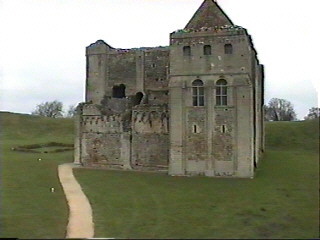 |
Although this review was written in August, we actually visited Castle Rising Castle in April,
on a very windy day. As we walked around the castle, there was a good amount of wind noise,
and it was still fairly cold, which in my opinion adds to the atmosphere of the place. And please excuse the rather dodgy pics, they are stills taken from a shakily held video camera! As we arrived at the Castle coming from King's Lynn, we were immediately struck by the castle dominating the skyline. Entering the car park gives an excellent view of what is in store. Go through the gap in the massive earthworks, and enter the shop to pay for admission tickets etc. There is a free taped Tour Guide available if you wish, which will take you through the Castle. If you choose not to take the Tour, there are still information signs dotted around, and the Guide Book does a good job. As you leave the shop, you walk through the Gatehouse and are presented with the view shown on the left. |
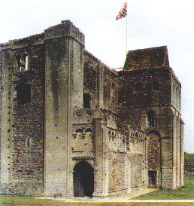 Looking North towards the Main Door. |
 Following the path, you enter the main doorway to the castle.
See the Gargoyles keeping an eye on you as you enter.
Following the path, you enter the main doorway to the castle.
See the Gargoyles keeping an eye on you as you enter.
|
|
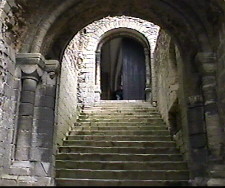 The main Stairs. |
As you pass through the doorway, you look straight up the Main stairs.
These stairs were the primary entrance to the castle, and would have taken you into the Entrance Vestibule,
which was a little ante chamber off the Main Hall. But we turned left, through a small doorway, into.... |
|
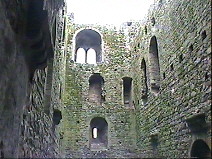 The southern basement looking West. |
The Basement. These two ground floor rooms were probably used just for storage. In both the southern and northern room's walls you can see the holes where the beams of the floor above were. Above the southern room was the Lord's Chamber. In the northern basement is a well, which is additional to the well outside the castle. The main hall was situated above this room. You can see the back of the fireplace in the picture on the right. This fireplace used to be the main doorway into the main hall from the Entrance Vestibule but was turned into a fireplace later. |
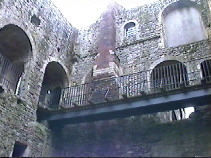 The northern basement looking up and East. |
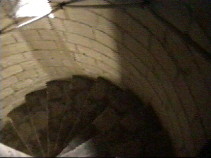 View down the stairs. |
In the North East corner of the northern basement lies the back stairs. In my view, a castle simply isn't a castle without at least one set of spiral steps! |
|
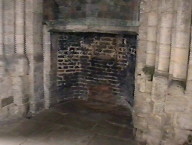 The Main hall's entrance archway. |
Half way up the steps, go left into the Entrance Vestibule. This was the quivalent of a lobby, the final room where guests would wait before going into the Main Hall and meeting the Lord. The original entrance arch to the main hall can still be seen, with it's lavish decoration. This entrance was blocked up in the 16th century by a fireplace. | 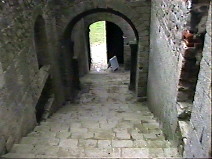 Looking down the main stairs from the Entrance Vestibule. |
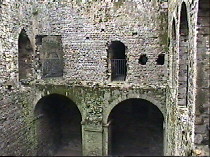 The Main hall looking West.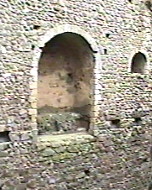 The Lord's Seat. |
After leaving the Entrance Vestibule, we proceeded to The Main Hall. Along the North Wall of this hall is a passageway. After the floor collapsed, there was no access to the Kitchens (at the West end of the main hall), so this passage was hacked through in the 16th century. The thickness of the walls here is amazing. On the South Wall of this hall is a recess where the Lord sat, his presence commanding the whole room. The fire would have been set upon a great stone slab in the center of the hall, which was probably rested on a bed of sand to prevent damage to the floor. The spaces for the floor joists can be clearly seen. A modern bridge spans one end of this hall to allow access to the other rooms on this floor, such as the Private Chamber, (where the Lord slept and conducted his private business), the Chapel and the Lord's private garderobes (medievel toilets). |
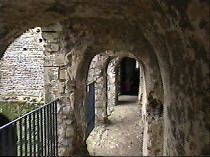 The passageway hacked through the north wall.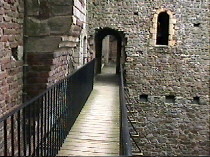 Bridge for access to other rooms. (Looking South) |
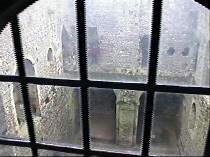 The Basment & Main Hall seen from Upper Rooms |
Carrying on up the spiral stairs leads us to the Upper Chambers.
These rooms were added in the 14th century after Queen Isabella had taken up residence.
The room above the entrance vestibule retains some of it's original character,
as it has some remaining plaster. This room was probably used to house the Rising's local constabulary, and also a mad naval captain was kept here for his own safety. |
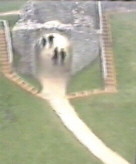 The Gate House as seen from the Upper Chamber. |
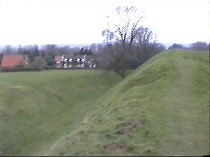 View North from the top of the West bank of the earthworks. |
Right, down the spiral stairs, into the Entrance Vestibule, descend the Main Stairs
and out into the Ringwork, the massive earthworks surrounding the castle. This ringwork used to be only half it's current height (120 feet in places), the massive upgrading taking place late 12th/early 13th century. There are ruins within the ringwork of a chapel, kitchen and a range of lodgings. There are also ruins of a medievel church dating to around the year 1100. This church remained hidden under the earthworks until the 19th century. The second well is within the ringwork, north of the keep. The Gatehouse is an original Norman feature, and dates to around c.1140. The grooves for the portcullis can be clearly seen, as can part of the staircase that originally ran up to a now vanished room and tower above. The Bridge & Walls over the ditch are of a later date, probably 14th Century. |
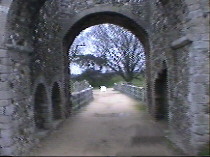 Looking East out of The Gate House . |
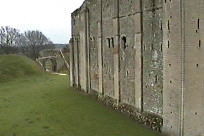 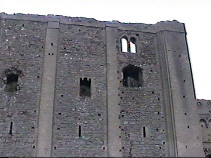
|
Summary That just about rounds it off, as this is only a brief guide. If Castles are your thing, go and see Rising for yourself to get the full experience. And if they're not, go anyway 'cos it's a good day out. Our 2 children (aged 5 and 3 at the time of the visit) had an excellent day, which means by definition that we parents had a good day also! We plan to go again this season, and this time take a picnic! Journey time: about 50 minutes each way. Duration of Visit: 4 hours plus. Overall Score: 8½ out of 10 |
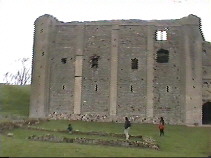 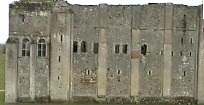
|
| Castle Rising Castle |
|
Castle Rising King's Lynn Norfolk PE31 6AH 01553 631330 Fax 01553 631724 |
| Opening Times | |
| 1st April to 1st November Daily 10am to 6pm (or dusk if earlier in October). |
2nd November to 31st March Wednesday to Sunday 10am to 4pm. |
| Closed Christmas Eve, Christmas Day and Boxing Day. | |
| Facilities |
| Large Picnic Area Car Park Toilets (including disabled) Shop Adjacent Tea Room |
This page done with kind permission of Mr. G. Howard, owner of Castle Rising Castle.
